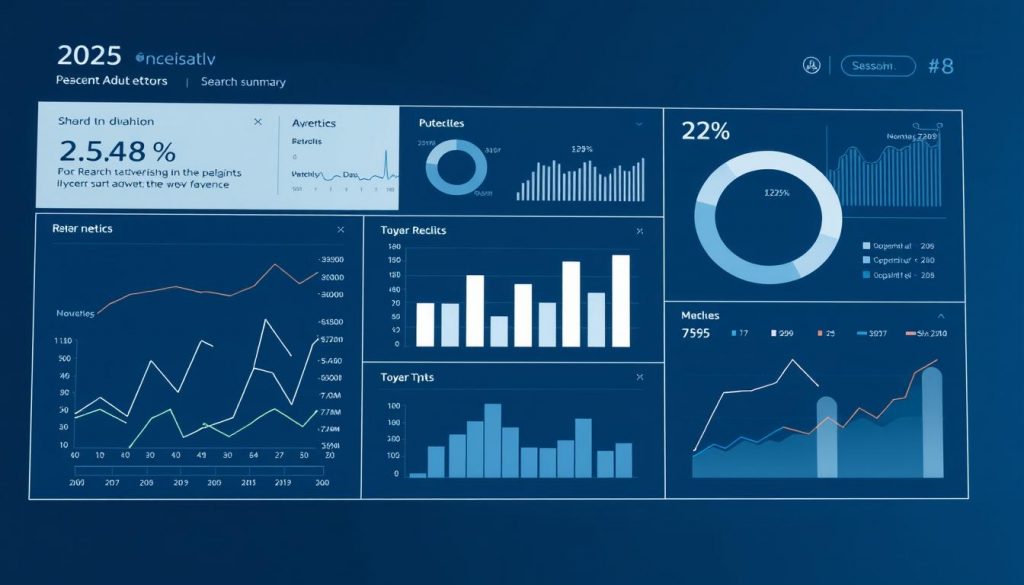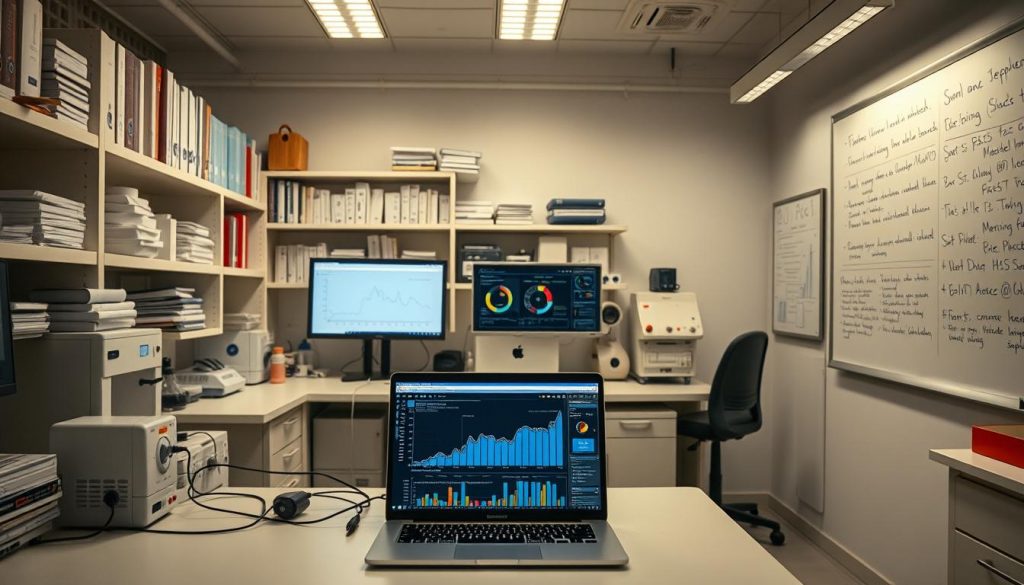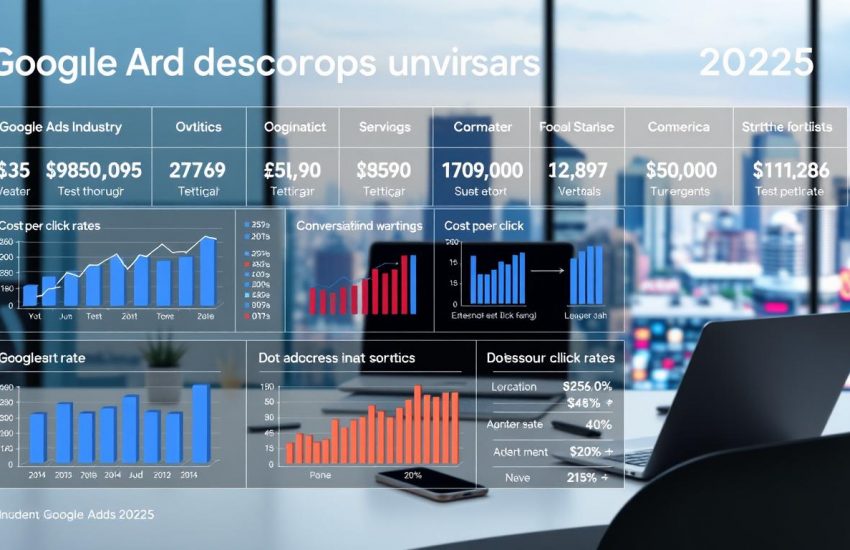“In the middle of difficulty lies opportunity.” — Albert Einstein.
We open this report with a clear goal: give you usable, comparable metrics that guide smarter budget and creative choices.
We analyzed large datasets spanning thousands of campaigns to show what matters in search performance: CTR, CPC, CVR, and CPL.
The trend is familiar. Costs rose over several years, yet click rates and conversion rates show resilience. This means thoughtful strategy still wins.
Our approach pairs recent, 2025-era results with historical context. That helps you tell long-term shifts from short-term noise.
Key Takeaways
- CTR, CPC, CVR and CPL together give a full view of campaign health.
- Costs trended upward, but many industries saw improved conversion rates.
- Median performance data helps set realistic targets for your business.
- Use these metrics to prioritize targeting, creative, and landing page fixes.
- We translate data into practical steps to improve search performance.
Executive summary: 2025 search advertising at a glance
Here we boil down the headline metrics so you can act fast on campaign priorities.
Quick take: Overall search performance improved even as costs rose. The average CTR reached 6.66% (+3.74% YoY). The average CPC climbed to $5.26 (+12.88% YoY). Conversion rate (CVR) rose to 7.52% (+6.84% YoY). Cost per lead averaged $70.11; CPL rose in 13 of 23 industries by ~5% versus much larger swings last year.
Across industries you’ll see clear winners and trade-offs. Arts & Entertainment led on CTR (13.10%). Attorneys topped CPC at $8.58. Auto Repair led conversion rate at 14.67% and also shows the lowest cost per lead at $28.50.

“Costs are rising, but stronger conversion lifts efficiency for many verticals.”
- Modest CTR gains, higher CPCs, improving CVR, more stable CPLs.
- Expect big variation by vertical; use these metrics to set realistic goals.
| Metric | Average | Top industry | Notable low cost |
|---|---|---|---|
| CTR | 6.66% | Arts & Entertainment 13.10% | — |
| CPC | $5.26 | Attorneys $8.58 | Auto Repair lower end |
| Conversion rate | 7.52% | Auto Repair 14.67% | — |
| Cost per conversion | $70.11 | Varies by vertical | Auto Repair $28.50 |
Methodology and sources: how this industry report was built
Our methodology explains how we turned raw campaign data into useful industry comparisons.
Scope and time frame: The core dataset covers April 2024–March 2025. We used 16,000 search campaigns across 23 U.S. industries to smooth seasonality and show persistent patterns.

Data sources and sample composition
We combined our primary sample with AgencyAnalytics medians from 150,000 campaigns across 7,000 agencies. That adds a budget and spend perspective.
For historical context, we referenced a WordStream 2018 sample to compare search and display performance.
Averages vs. medians: why both views matter
We report averages for overall trends and medians to limit the influence of big spenders. That helps you interpret a single number correctly.
- Primary dataset: 16,000 campaigns, CTR, CPC, CVR, CPL with YoY comparisons.
- Agency medians: spend patterns and stable central tendencies.
- Historical sample: channel context for search vs. display differences.
“We use transparent sample sizes so you can apply these numbers with confidence.”
Use this guide to match the presented metrics to your accounts. We show both average and median views so your marketing decisions are based on context, not on a single number.
Click-through rate benchmarks: engagement trends by industry
Click behavior across verticals reveals where intent and creative meet.
Average CTR in 2025 and what “good” looks like
Our average CTR in 2025 sits at 6.66% (+3.74% YoY). That number is a useful target for many accounts.
Above 6.66% usually signals strong headline and keyword fit. Below it, you should review match types, negative keywords, and ad copy alignment with the audience.
YoY CTR movement: modest gains overall, mixed by vertical
Overall CTR rose modestly, but industries diverged sharply.
- Gainers: Shopping & Gifts +14.07%, Home Improvement +13.95%, Attorneys & Legal +12.64%.
- Decliners: Beauty & Personal Care -15.41%, Travel -14.07%, Restaurants -12.67%.
These swings reflect shifts in SERP layout, creative formats, and competition for keywords.
Standout performers and laggards: Arts & Entertainment vs. Dental and Business Services
Top CTRs: Arts & Entertainment 13.10%, Sports & Recreation 9.19%, Shopping & Gifts 8.92%.
Lowest: Dentists 5.44%, Auto Repair 5.56%, Business Services ~5.65%.
“Higher CTR often follows clear intent and timely creative; lower CTR can mean informational queries or broad targeting.”
We recommend focusing on audience signals and tighter keyword sets when CTR lags. In some cases, a lower CTR is acceptable if clicks are more qualified and conversion improves.
| Metric | Value | Action |
|---|---|---|
| Average CTR | 6.66% | Use as baseline for industry comparisons |
| Top industry CTR | Arts & Entertainment 13.10% | Model creative and intent signals from top performers |
| Lowest industry CTR | Dentists 5.44% | Tighten keywords; add audience filters |
| Biggest YoY gain | Shopping & Gifts +14.07% | Test similar formats where demand rises |
Cost per click (CPC) in 2025: rising costs and competitive pressure
Rising auction pressure is reshaping what marketers pay for each search click.
Average CPC reached $5.26. That small per click increase compounds quickly across volume campaigns. Even a $0.50 rise changes monthly spend and return on ad spend.
Some industries pay a clear premium. Attorneys & Legal lead at $8.58. Dentists and Home Improvement follow at $7.85. Education averages $6.23.
YoY movement and where costs moved
Overall cpc rose +12.88% year over year. However, not every market climbed.
- Costs eased in Arts & Entertainment (-6.98%) and Restaurants (-5.96%).
- Sharp increases hit Beauty & Personal Care (+60.11%) and Education (+41.91%).
- Shopping & Gifts jumped +33.72% while Legal ticked down -4.03%.
How to protect performance
Competition, bidding strategy, ad relevance, and landing pages drive what you pay. Smart bidding can lift CPC when it chases conversions.
We recommend segmenting branded versus non-branded terms, tightening keyword sets, and improving landing page alignment. These steps raise Quality Score and can lower cost per click without cutting volume.
“Small per click gains matter: tighten relevance, test bidding guardrails, and monitor queries to defend efficiency.”
| Metric | Value | Action |
|---|---|---|
| Average CPC | $5.26 | Review budget impact at scale |
| Highest CPC industries | Legal $8.58, Dentists $7.85, Home Improvement $7.85 | Prioritize lifetime value and narrow targeting |
| Lowest CPC industries | Arts & Entertainment $1.60, Restaurants $2.05, Travel $2.12 | Scale high-volume keywords; test creative |
| YoY change (overall) | +12.88% | Stress-test bids and guardrails |
Conversion rate (CVR) benchmarks: proof of performance under pressure
Conversion outcomes reveal which industries turned clicks into customers.
Average conversion rate reached 7.52% (+6.84% YoY). That sets a realistic target for many campaigns and helps you judge performance across verticals.
Cross-industry context
Top performers: Auto Repair 14.67%, Animals & Pets 13.07%, Physicians 11.62%. These services convert well when intent is urgent.
Lowest rates: Finance & Insurance 2.55%, Furniture 2.73%, Real Estate 3.28%. Longer decision cycles and price sensitivity reduce conversions here.
YoY shifts and implications
Big gains: Education (+43.87%), Sports & Recreation (+42.43%), Apparel (+14.69%).
Big declines: Career (-23.09%), Restaurants (-18.69%), Home Improvement (-14.97%). Rising CPCs can erode conversion if traffic intent falls.
“Stronger landing offers, clear calls, and accurate tracking protect conversion outcomes as costs move.”
- Match ad promise to page to improve conversions.
- Test offers and on-page actions (calls, forms, chat).
- Use conversion tracking and offline attribution to protect ROI.
| Metric | Value | Action |
|---|---|---|
| Average CVR | 7.52% | Use as cross-industry anchor |
| Top industry | Auto Repair 14.67% | Model urgency and service clarity |
| Lowest industry | Finance 2.55% | Focus on trust signals and longer funnels |
Cost per lead and CPA benchmarks: the “money metrics” for ROI
Cost per lead is the clearest way to judge whether your marketing spend is truly buying customers. We use CPL and CPA to measure what each desired action actually costs your business. That clarity makes budget choices easier and keeps campaign decisions tied to ROI.
Average CPL in 2025 and how it varies by industry
The average cost per lead is $70.11. Some industries sit far below that.
Lowest CPLs: Automotive—Repair $28.50; Restaurants & Food $30.27; Arts & Entertainment $30.27; Animals & Pets $31.82. Highest CPLs: Attorneys & Legal $131.63; Furniture $121.51; Business Services $103.54.
YoY CPL trends: stability returns after volatile years
This year 13 of 23 industries saw CPL increases, but the average rise was ~5%—much lower than the prior year’s ~25% spike. That points to more stable market balance and clearer signals for scaling.
CPL is shaped by CTR, CPC, and CVR working together. Where conversion rate improves, CPL often falls even if costs per click rise.
- Why it matters: CPL and CPA are the money metrics—each lead equals a future sale or action you can value.
- How to lower cost per: improve Quality Score, streamline forms, and use value-based bidding with clean conversion data.
- Segment by funnel: separate top-funnel awareness from bottom-funnel intent to control acquisition costs while keeping volume.
- Industry cues: complex services and long sales cycles tend to raise CPL; adjust offers and nurturing accordingly.
- Monitoring: set weekly checks to catch gradual CPL creep before it erodes profit.
“Treat CPL as a control metric — not a target in isolation — and align it with lifetime value.”
| Metric | Value | Action |
|---|---|---|
| Average CPL | $70.11 | Set as cross-industry anchor |
| Lowest industries | Auto Repair $28.50; Restaurants $30.27 | Scale high-performing campaigns |
| Highest industries | Legal $131.63; Furniture $121.51 | Prioritize lead quality and LTV |
Google Ads benchmarks 2025: budget and spend patterns in the United States
Median monthly spend tells a simple story: some industries must invest early, others can scale later.
AgencyAnalytics medians show the overall monthly spend at $1,057.45. Category medians vary widely.
High-budget categories include Roofing at $2,219.40, Attorneys & Legal $1,637.17, and Furniture $1,489.29. Mid-range examples: Dental Services $1,156.61 and Home Improvement $1,206.36.
Lower medians let lean businesses start small. Restaurants average $679.78 and can scale volume with lower CPCs (Restaurants median CPC ~$0.60).
- Seasonality matters: Weddings & Events dips in winter (~$797.02 in November) and rises in spring.
- High CPC verticals (Roofing CPC ~ $8.57; Legal ~ $4.96) often require larger early budgets to learn and win auctions.
- Pair search and display to balance scale and efficiency.
“Anchor budget to unit economics — costs, lead value, and close rate — then pace spend to match cash flow.”
| Category | Median monthly spend | Median CPC (notable) |
|---|---|---|
| Roofing | $2,219.40 | $8.57 |
| Attorneys & Legal | $1,637.17 | $4.96 |
| Restaurants | $679.78 | $0.60 |
| Home Improvement | $1,206.36 | — |
We translate these medians into practical guidance so your campaigns launch with budgets that fit your goals. Start with a realistic number and give your account time to learn.
From search to display: using benchmarks to guide optimization
Side-by-side channel context gives clarity on which metrics to prioritize at each funnel stage.
Channel context: why search and display differ on CTR, CPC, and CVR
Search and display serve different user intent. Search captures clear intent at the moment of need. Display builds awareness and nurtures an audience over time.
Historical medians from WordStream (2018) show this gap: search CTR 3.17% vs display 0.46%; CPC $2.69 vs $0.63; CVR 3.75% vs 0.77%; CPA $48.96 vs $75.51. AgencyAnalytics medians confirm the pattern across industries.
Optimization levers tied to each metric
- CTR: sharpen keywords, stronger hooks in ads, and tighter audience targeting to lift clicks.
- CPC: improve ad relevance and landing experience; adjust bidding to favor profitable queries.
- CVR: match offers to intent, simplify forms, add trust signals, and test page layouts to reduce friction.
- CPL: segment campaigns by funnel, set target thresholds, and align creative and budget to the expected value.
“Use display to fill the top of the funnel and retarget; use search to capture bottom-funnel demand.”
We leave you with a practical strategy: set separate goals for each channel, track the right metrics per funnel stage, and run daily checks on bids, audience, and creative. This guide turns comparative data into action for your next campaign.
| Channel | CTR | CPC | CVR |
|---|---|---|---|
| Search | 3.17% | $2.69 | 3.75% |
| Display | 0.46% | $0.63 | 0.77% |
Industry spotlights: Real Estate, Legal, Home Improvement, and Restaurants
In this spotlight we compare four high-impact verticals where search moves dollars and decisions.
High competition and value: Legal and Home Improvement
Legal: CPC $8.58 (YoY -4.03%), CTR 5.97%, conversion rate 5.09%, CPL $131.63. High competition and lead value mean you must qualify before you spend.
We recommend tight keyword sets, strong ad copy, and faster lead routing. For google ads, use lead validation and negative keyword lists to protect spend.
Volume vs. efficiency trade-offs: Real Estate and Restaurants
Real estate: CTR 8.43%, cost per click $2.53, CVR 3.28%, CPL $100.48. Interest is high, but many inquiries need faster follow-up to convert.
Restaurants: CTR 7.58%, cpc $2.05 (YoY -5.96%), CVR 7.09%, CPL $30.27. Local capture scales well with simple menus and reservation paths.
“Focus where lifetime value offsets higher acquisition cost.”
- Use ad extensions and local services pages to win competition on intent.
- Apply dayparting and geo bidding to match real-time demand.
- Prioritize Home Improvement and Legal for high value; lean on Restaurants for volume.
| Vertical | CTR | CPC | CPL |
|---|---|---|---|
| Legal | 5.97% | $8.58 | $131.63 |
| Home Improvement | 6.37% | $7.85 | — |
| Real Estate | 8.43% | $2.53 | $100.48 |
| Restaurants | 7.58% | $2.05 | $30.27 |
Conclusion
Use this closing note to tighten strategy and protect ROI across your campaigns.
Key recap: CTR sits at 6.66% (+3.74% YoY), CPC is $5.26 (+12.88% YoY), conversion rate is 7.52% (+6.84% YoY), and average CPL is $70.11 (about +5% in 13 of 23 industries).
Treat google ads benchmarks and ads benchmarks as context, not commands. Across industries, rising cost per click makes discipline vital. Still, better CTR and conversion show that solid execution improves performance.
Next steps: audit wasted spend, align messaging to audience needs, and improve landing pages. Track weekly, adjust search versus display goals, and review benchmarks quarterly.
We can help you turn these numbers into action and keep your marketing healthy.


